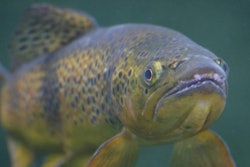
Aquaculture is the fastest-growing industry in the agriculture sector, but it needs to do more to improve production and increase efficiencies, according to Ioannis Nengas, aquaculture nutrition expert for Alltech.
Nengas spoke at the Alltech ONE Ideas Conference, held in Lexington, Kentucky, May 22-25. He said that, because the aquaculture industry is still young, it needs to better identify challenges and focus on areas that need improvement.
The aquaculture industry uses 40 million tons of aquafeed annually. But that number will double by 2030 due to the demands of global population growth, Nengas said.
“The basis of increasing sustainable production is through nutrition,” Nengas said. “But we need to lower the cost of feeding.”
Improving profitability through feed, better management
Feed makes up 50-60 percent of total aquaculture production costs. To lower costs and to provide sustainable ingredients, Nengas believes aquafeed will increasingly include utilize vegetables; insects; and single-cell organisms, such as yeast, bacteria and algae.
To increase the profit margin in aquaculture, Nengas notes, the industry needs to fully understand the nutritional requirements of fish, use feed additives to support growth and manage stressors, and improve feed management.
In addition, health problems and diseases need to be better managed. This includes improving disease diagnosis methods, developing more vaccines that are more specific and can be orally administered, utilizing health management systems that incorporate microbial management, improving genetics, and strengthening biosecurity.
“Aquaculture will play a great role in providing protein for the growing population, but this has to go through a road of sustainable management,” Nengas said. “Key challenges have to be addressed and solved in all phases of production.”
Focus on breeding programs, genetics
“Genetic research is something that I believe will bring aquaculture to the next stage,” Nengas said. “It’s done for most of the species with different levels of success, but we are at the bottom of this. So, there is a lot of work to be done to improve our production capacity through genetic research, specifically through programs of selective breeding.”
He cited breeding programs that have created salmon that consumes 25 percent less feed than they did a few decades ago and brings fish to final market size in half the time.
He said there are more than 200 species grown in aquaculture, and research and development is spread out among all those species, so the industry must narrow down the number of species grown. He said breeding programs need to focus on the following qualities:
- Fast growth
- Breed well in captivity
- Disease tolerance
- Good feed conversion ratios
- Tolerance to environmental stressors
- Low production cost
- High selling price
Nengas said carp, tilapia, catfish, salmonids, tuna and yellowtail best capture those qualities.









